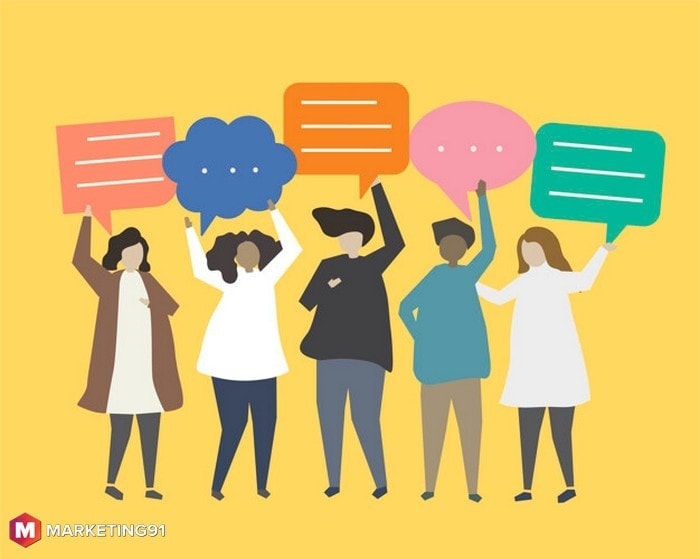
The Essential Elements and Benefits of Effective Communication

Communication is the exchange of meaningful messages between people using various mediums It involves a two-way process, continuous in nature, and aims to establish mutual understanding Effective communication ensures clarity, transparency, and inspires others It is a foundation of management and interdisciplinary in nature
Communication is a way by which meaningful messages can be conveyed across people to convey ideas. Any kind of medium may be used by communication to convey the message.
What is Communication?
The act of communication involves the exchange and comprehension of information. It is a dynamic process that is subject to constant change and cannot be rigidly defined. Feedback, shifts in perspective, and other relevant factors can all influence this process, altering the existing state of affairs. To illustrate, commuting to work brings about a change in perspective due to the interaction with a new set of people. This shift in perspective alters the communication process.
Comprehending and interpreting written and spoken language is an integral aspect of communication. For instance, while watching a movie, one can understand the plot and message more effectively than by simply viewing still images lacking sound or context. The final component of communication is sharing, which refers to engaging in an activity with others.
Thus, communication involves the integration of various elements to create a clear and informative exchange of information between a sender and one or more recipients.
Communication is the backbone of our modern society, without which we would be unable to function in our daily lives. From the simplest gestures like a nod or handshake to more complex forms like speeches and songs, communication is woven into every aspect of our day-to-day interactions. It facilitates the exchange of ideas and allows us to better understand the perspectives of others, making it an essential tool for effective collaboration and cooperation.
Learning cannot exist without communication. Text, pictures, sound, or sign language are essential tools for teaching. Communication is also necessary for the exchange of ideas and thoughts. Businesses and individuals alike would struggle to survive without effective communication.
Elements of Communication Skills
It is essential to understand the vital components of communication to understand the process of communicating clearly.
Following are eight different components of communication
1. Source
The originator of a message is known as the source. This individual is responsible for initiating and sending the message to the receiver. In a conversation, the person speaking to a group can be considered the source of the spoken content.
Verbal and nonverbal communication aids the source in conveying their message effectively.
The transmission of ideas or thoughts from the source to the receiver can involve both written and visual forms of communication. The ultimate goal of the source is to effectively convey their message to the recipient.
2. Message
Visual communication revolves around delivering a message, which is essentially the structured format of communication. This can be achieved through a series of images that tell a story or a combination of letters that convey a particular message. However, it's important to note that the effectiveness of the message relies not only on the words used but also on the tone, modulation of voice, and overall approach in conveying the message to the recipient.
In different forms of communication, different factors come into play. Verbal communication relies on tone and voice modulation, while written communication requires attention to grammar and punctuation. Non-verbal communication is heavily influenced by gestures and body language, and visual communication depends on the quality and setting of the images used.
3. Channel
A channel is the means by which messages are transmitted from one point to another. It plays a critical role in ensuring that the message is conveyed successfully from the source to the destination.
If the message is not transmitted, then the desired action will not be taken, and the communication process will not be valid.
4. Receiver
The recipient is responsible for receiving the message sent by the sender. This individual is either the final destination for the communication process or the source for initiating the feedback process. The recipient's ability to perceive and interpret the message is dependent on the mode of communication, whether it be visual, auditory, or tactile. For effective communication to occur, both the sender and recipient must be aligned in their understanding. Without this alignment, the communication fails to achieve its intended purpose.
There could be many differences between the sender and receiver, and for optimum communication to happen, those differences should be as low as possible.
5. Feedback
Upon receiving a message, the receiver's next step is to comprehend and derive meaning from it. Once the message is understood, the receiver provides feedback to the sender, effectively switching roles. This exchange of feedback highlights the two-way nature of communication, where both parties aim to convey and receive messages.
This feedback will be based on the message which is initially sent from the sender and will be sort of an answer to that message.
6. Environment
The environment in which we receive a message encompasses various elements such as surrounding equipment, objects, climate, and other present factors during the communication process. This external surrounding is also referred to as the environment when engaging in face-to-face conversations with others.
Understanding the environment is crucial in effective communication. Just like a party may have a dress code and an office may require formal attire, a theater with a packed audience also has certain expectations for appearance and behavior. Therefore, it is important to not only dress appropriately but also adjust your communication style to fit the environment.
7. Context
The setting or scene of communication is known as the context. For instance, formal business discussions like presentations occur in a group setting, thus, the appropriate context for such discussions is formal. Conversely, communication within a family is often casual. Context is determined by the expectations people have for your behavior in particular settings, which are often established by environmental cues.
8. Interference
In the realm of communication, interference is synonymous with noise. Its purpose is to disrupt or impede the flow of information, resulting in only partial or no reception of the intended message by the recipient.
When a baby cries in a theatre during the climax of a movie, it can be distracting and disrupt the intended message of the film. However, external noise is not the only type of disturbance that affects our focus. Psychological noise, such as thoughts that occupy our minds while we work, can be just as detrimental. These interruptions can occur more frequently than we realize and have a significant impact on our productivity. Without psychological interference, we could potentially be ten times more productive than we currently are.
Sometimes, despite receiving a clear message, our minds can misinterpret it. An instance of this would be if someone received an invitation card stating "Black tie only," but then showed up to the event wearing only a black tie. This misinterpretation can cause significant confusion and disruption.
Functions of Communication Styles
Some of the common functions of communication are…
1. Informing
This type of communication serves the purpose of providing information. It is utilized to acquire and distribute informative messages through various verbal and non-verbal means.
2. Regulating or Controlling
Communication serves a second function of influencing and regulating the behavior, inclinations, and emotions of those involved. Nonverbal cues and signals shared by the speaker or writer can regulate or control the actions of the listener. Similarly, listeners also have the ability to regulate or control the interaction by giving certain signals.
3. Social Interaction
Social relationships are built through the function of interpersonal communication, which involves social interaction to form bonds, relations, intimacy, and connections with both internal and external parties of an organization, including employees, leaders, suppliers, investors, and customers.
4. Motivating or Persuading
Motivating, persuading, and influencing are among the primary purposes of communication. In the field of business management, these skills are essential for managers and leaders to possess in order to effectively inspire their teams.
5. Reducing Misunderstanding
Effective communication is a vital component in mitigating confusion, conflict, misunderstanding, and controversies. It serves as a solution to overcome these obstacles, which is why organizations implement both upward and downward communication systems to address various issues and discrepancies.
6. Decision/Choice Making
Effective communication is crucial for successful decision-making, both in personal and professional settings. By sharing information and viewpoints, communication facilitates the decision-making process, involving everyone from top-level management to lower-level employees.
7. Solving Problems/Troubles
Communication plays a vital role in overcoming the obstacles we face in both our personal and professional lives. Whether it's a face-to-face interaction or an exchange of facial expressions, effective communication can help us resolve issues and find the best possible solutions. By communicating with the person responsible for the issue at hand, we can avoid misinterpretation or bias and ensure that our concerns are addressed properly.
Nature of Communication
A communication process may have the following nature.
1. Two-way process
Communication revolves around a two-way process in which at least a sender and a receiver participate, as one individual will not be able to communicate with himself.
2. Verbal and non-verbal
Communication possesses a crucial quality of being both verbal and nonverbal. Verbal communication employs words to convey information, whereas nonverbal communication utilizes body language, gestures, postures, etc., as a medium to communicate emotions.
3. Continuous process
The exchange of ideas and opinions is a crucial aspect of the communication process, which involves ongoing interactions and discussions. These interactions are integral to the decision-making processes within an organization.
4. Goal-oriented
Effective communication is characterized by a focus on achieving the goals of all involved parties. Goal orientation is a crucial aspect of successful communication, as it ensures that participants are able to accomplish their intended objectives.
5. A Medium, not an end
Communication is not just a means of transferring information between individuals; it serves as a tool to achieve goals and reach desired outcomes.
6. Mutual understanding
Communication sets the ground for mutual understanding. Participants of a communication process develop a mutual understanding of the shared topic, subject, or message.
7. Dynamic process
Human communication is a fluid and ever-evolving process that adapts to the situation and preferences of both the sender and receiver. It takes on different forms and utilizes various mediums, making it a dynamic process that is always in flux.
8. Exchange
Communication is a fundamental aspect of human interaction, allowing individuals to share their ideas, thoughts, and feelings with one another. It involves the exchange of information and opinions, with the ultimate goal of developing a mutual understanding between the parties involved.
9. Pervasive
Communication is also ubiquitous as it is present everywhere. It takes place at different levels of professional, personal, or organizational structure.
10. Foundation of management
Effective communication is essential in managing various professional activities, including organizational planning and development. It serves as a crucial element in channelizing all managerial functions.
11. Inter-disciplinary
Effective communication is enhanced by deriving knowledge and information from various fields and sciences, including anthropology (study of body language), psychology (study of attitude), sociology (study of human behavior), among others. With the integration of such information and effective communication techniques, communication is strengthened and becomes more efficient. You may find this video on Communication informative.
Features of communication
1. Communication takes place between at least two or more people
Effective communication hinges on the parties involved in the process. Typically, communication occurs between two or more individuals, with one serving as the recipient of information and the other as the transmitter. It's worth noting that communication is a two-way street, meaning both parties have the ability to share information in real-time.
2. A two-way process
As we have learned already that communication is a two-way process where all parties involved in the communication process exchange ideas and information with one another.
However, communication is not complete unless the message is not understood and acknowledged by the receiver of the message.
3. The message
In order for communication to be effective, it must convey a meaningful message. This means that having a clear message is essential in both written and verbal communication. A message can take many forms, such as an idea, piece of information, set of instructions, or suggestions. Without a message, communication is essentially pointless.
A communication is called effective if it delivers the intended message properly, and there will be no communication with no message.
4. Dynamic in nature
Communication is an ever-changing process that adapts to the participants' moods and mindsets. Depending on the shared information and the level of interest from those involved, it can last anywhere from a few seconds to several hours.
For example, a meeting between the manager and his subordinates can last for 10 minutes or can also last for hours, depending on the discussion taking place in the meeting.
5. Establish mutual Understanding
It is crucial for communication to ensure that both parties involved have a clear understanding of the information being exchanged. This requires the receiver to receive and comprehend the information in the same way the sender intended. Without this mutual understanding and acknowledgement, communication cannot be deemed successful.
6. Response
Communication will be considered complete only if the appropriate response is received by the sender of the message.
7. Systematic
Every element of communication is interconnected, meaning that any alteration to one component can impact the entire message being conveyed. Let's say a boss and a subordinate are having a phone conversation; even the slightest issue with the phone connection could alter the information being exchanged.
8. Form of communication
Communication can manifest in various forms. It can be conveyed through oral, written, or gestural means. Formal communication typically involves oral and written modes, which are commonly utilized in business settings. On the other hand, gestural communication involves transmitting information through hand gestures or eye contact.
It is an informal type of communication which is widely used in the informal environment but is not acceptable and considered appropriate in the formal environment.
9. The flow of information
Communication within an organization can occur vertically, between a superior and their subordinates, or horizontally, between colleagues at the same level. This form of communication is known as side-to-side communication and can be both formal and informal.
Formal communication occurs within the established channels of an organization while informal communication happens outside those channels. An employee sharing information from a circular with a colleague is a formal communication, whereas sharing a rumor about a coworker is an example of informal communication.
10. A continuous Process
Communication is a never-ending process that involves the exchange of information between parties. An instance of this is when a manager gives directives to his team members in order to accomplish tasks in the workplace.
Role of Communication
Effective communication is a critical aspect of successful leadership. A skilled leader understands the importance of communicating effectively with their team to increase productivity over time. There are several key qualities that are necessary for effective communication within an organization:
1. Ensuring Clarity of Message Delivery
All effective communication methods are easy and straightforward. They are subtly clear and concise with the organization’s work.
Clear and effective communication is essential for any successful leader. It is important to communicate with clarity and avoid any misunderstandings. This can be achieved by setting clear goals that are understood by everyone involved. Team leaders play a crucial role in providing this clarity and ensuring that everyone is on the same page. Additionally, it is important to ask specific questions, such as the timeline for the project, to make informed decisions. Vague communication can lead to unproductive stages and hinder the overall success of the organization.
2. Communication to establish personalization
To communicate with everyone in the room is a tedious task. But an effective leader knows that everyone is essential in the room and has a voice.
By taking the time to get to know each team member on a personal level, an individual can build a deeper level of trust and confidence. This open and honest communication can then lead to more effective collaboration and the ability to share thoughts and ideas directly with leaders or managers.
3. Ensuring transparency in work
Effective communication relies heavily on transparency. A leader should strive for transparency in all their actions within an organization, as their fellow employees are constantly observing their every move without obstruction.
The transparent nature of the leader allows all employees to have visibility into the various working processes. With no hidden agenda, the employees can operate with clarity and without the need to decipher any hidden messages.
The deprivation of transparency leads to uncertain situations in the organization. This causes distrust and anxiety within the organization.
4. Listening to everyone and feedback system
The process of communication involves both a sender and a receiver, each with their own unique role. In the workplace, team leaders make a conscious effort to listen to their colleagues and understand their perspectives in order to work towards achieving organizational goals. By fostering effective communication, relationships between employees are strengthened, leading to improved accuracy and clarity in all aspects of work.
Great leaders carefully analyze messages before drawing conclusions, placing utmost importance on this process. They take full responsibility for every decision they make, rectifying any mistakes quickly to prevent significant losses for the organization. They approach this with a sense of authenticity and humility, devoid of any exaggerated theatrics.
5. Offering the ability to inspire
It is the most vital element of effective communication. In this, the influential leaders have to inspire their teammates to that level to perform exceptionally well.
Leaders who possess a clear vision of success are able to effectively guide their organization towards achieving their goals. The ability to communicate and inspire team members is a crucial skill that falls solely on the shoulders of the leader. Exceptional communication is a defining characteristic of successful organizations, leading to increased productivity and profitability.
Advantages of Good Communication
Effective communication is a crucial aspect of successful leadership, as it can greatly enhance the overall functioning of an organization. The benefits of good communication are numerous, including increased employee efficiency. When communication is clear and consistent, employees are better equipped to perform their roles and responsibilities with ease, as they have access to all the necessary knowledge and information.
Improved communication can lead to better customer satisfaction, increased sales, and stronger brand reputation. In addition, clear and open communication within the organization can improve employee morale, productivity, and ultimately, the bottom line. Thus, investing in effective communication strategies is crucial for any business looking to succeed in today's competitive market.
Through effective communication, leaders have the opportunity to reach their desired audience and convey the value of their products and services. By crafting compelling narratives, they can demonstrate to their existing customers why their offerings are relevant and valuable.
Conclusion
, it is important to understand the impact of nonverbal communication, such as body language and tone of voice, on the message being conveyed. By paying attention to these cues, individuals can ensure their messages are being received as intended. Additionally, active listening and asking clarifying questions can improve understanding and prevent misunderstandings. Overall, effective communication requires attention to both verbal and nonverbal cues, as well as an understanding of the context and audience.
Objectives Of Communication




















